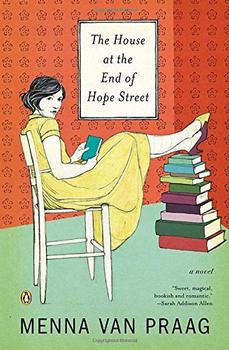Summary | Excerpt | Reading Guide | Reviews | Beyond the book | Read-Alikes | Genres & Themes | Author Bio

A couple of years ago, author Menna van Praag had a vision to "build an enormous house and let writers, artists, actors, singers live there for a year and fulfill their dream while not having to worry about paying the bills and just have all expenses paid." Since she has not yet earned the "millions of pounds" needed to make the dream a reality, she wrote a book about it instead.
The House at the End of Hope Street is that book, and the titular house, at 11 Hope Street, is van Praag's dream house. It is a mysterious and magical place in Cambridge, England:
The house has stood at the end of Hope Street for nearly two hundred years. It's larger than all the others, with turrets and chimneys rising into the sky. The front garden grows wild, the long grasses scattered with cowslips, reaching toward the low-hanging leaves of the willow trees. At night the house looks like a Victorian orphanage housing a hundred despairing souls, but when the clouds part and it is lit by moonlight, the house appears to be enchanted. As if Rapunzel lives in the tower and a hundred Sleeping Beauties lie in the beds…Alba doesn't know what she's doing, standing on the doorstep, staring at the number eleven nailed to the silver door. She's lived in Cambridge for four of her nineteen years, but has never been down this street before. And there is no reason for her to be here now, except that she has nowhere else to go.
In fact, the house is invisible to most passersby, so even if Alba had been walking on Hope Street before – before she went to school, before the awful thing happened to her, before she had nowhere to go – she wouldn't have seen it. She wouldn't have needed to see it. She wouldn't have actually needed it. But as the novel opens, she does need it, and so the house's veil has been lifted. The women who enter through the doors of 11 Hope Street must all follow one rule, which Alba learns right away: every one of them is allowed to stay while she gets her life back in order, but must do so within 99 days. Alba is desperate and so she decides to accept. Besides, there is something deep and compelling about the house, as if it, not Peggy, the old and beautiful proprietress, is offering her a place within its walls.
This personification works really effectively. Van Praag gives just the right kinds of details, without being heavy-handed, to make the house come alive:
...the walls breathe, gently rising and falling beside Alba and the stripped oak floorboards soften under her feet and the lightbulbs and lampshades pull at the ceiling to get a closer look at her.
Peggy's character is a highlight. The house has been in her family for years. She loves it, takes to heart her gift and responsibilities within it, and is good at what she does. She is earnest in her caretaking and has a huge heart. She is funny and indulgent, someone who loves chocolate cake and sex. Along with Alba, two other residents live at the house. They too are there for 99 days to get their lives in order. There's an aging actress named Greer, who has her own secret tucked away; and Carmen, a singer who is haunted by both a memory and an object. Despite their distressed states of mind, which cause them to cope in unpredictable ways, Greer and Carmen are well-drawn, likeable women. This is a credit to van Praag who is great at striking a balance between action and feelings.
Coupled with her wonderful ability to convey emotion, the book feels both magical and grounded at the same time. In fact, while reading, it becomes easy to believe that houses such as 11 Hope Street do actually exist. Its walls are studded with photographs of hundreds of other women who once resided here – including famous ones such as Florence Nightingale, Gertrude Stein, and Vivien Leigh. They come to life every now and then, offering advice and a strong shoulder to cry upon. Van Praag makes the past come alive and the result is a story that strikes deep historical roots while blooming in wild, surreal color.
The House at the End of Hope Street is a fast-paced, charming, lovely read. Readers who appreciate magical realism, women's history, and the power of love will thoroughly enjoy this book. Until Menna van Praag makes those millions and opens her own enchanted house, the one at 11 Hope Street is the place to be.
![]() This review was originally published in The BookBrowse Review in May 2013, and has been updated for the
April 2014 edition.
Click here to go to this issue.
This review was originally published in The BookBrowse Review in May 2013, and has been updated for the
April 2014 edition.
Click here to go to this issue.

If you liked The House at the End of Hope Street, try these:

by Sharon Guskin
Published 2017
Noah wants to go home. A seemingly easy request from most four year olds. But as Noah's single-mother, Janie, knows, nothing with Noah is ever easy. One day the pre-school office calls and says Janie needs to come in to talk about Noah, and no, not later, now - and life as she knows it stops.

by Kate Racculia
Published 2015
A high school music festival goes awry when a young prodigy disappears from a hotel room that was the site of a famous murder/suicide fifteen years earlier.
Your guide toexceptional books
BookBrowse seeks out and recommends the best in contemporary fiction and nonfiction—books that not only engage and entertain but also deepen our understanding of ourselves and the world around us.